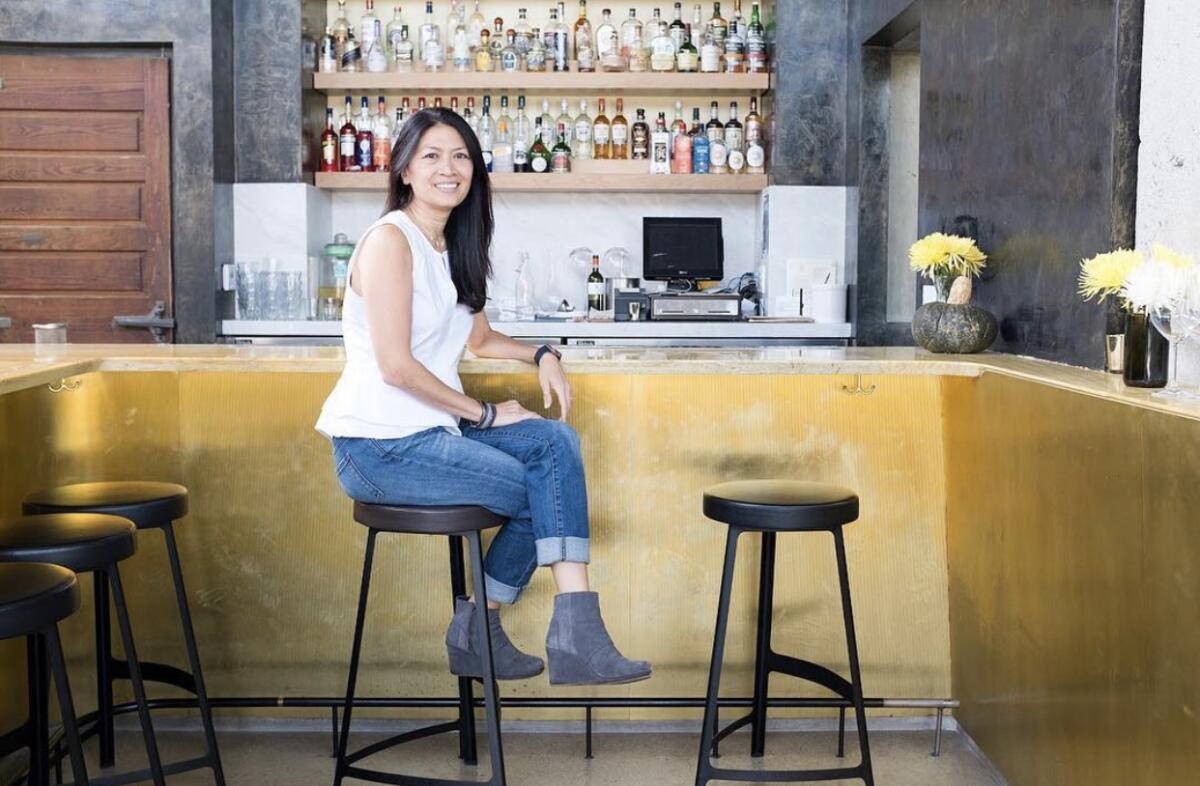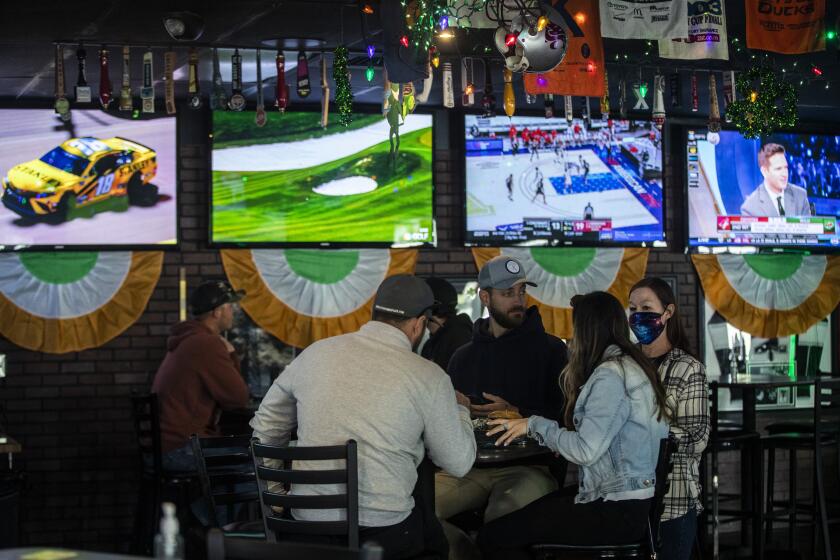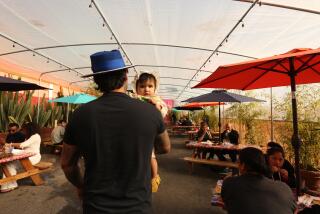Many L.A. restaurants are racing to get ready for indoor customers; others are waiting

As indoor dining returns at 25% capacity on Monday, some L.A. County restaurateurs are racing to convert their makeshift offices and to-go assembly lines back into dining rooms this weekend. Others await higher vaccination rates and, after a full year of open-close whiplash, more instruction and time.
It’s been one year since David Kuo seated guests inside Little Fatty, his Taiwanese dim sum restaurant in Mar Vista.
Throughout the pandemic the chef-owner’s restaurant and its adjacent bar, Accomplice, turned to takeout to keep the lights on. To outweigh the cost of staffing servers, bartenders and a host, Kuo says he would have needed a 30-seat setup on the front sidewalk, and he didn’t have the space until he recently signed a lease on another adjacent building, which includes a 3,000-square-foot parking lot.
Kuo is outfitting that lot for outdoor seating and readying three dining rooms. “We’re really, really excited,” Kuo said. “It’s kind of hard to put food in a box and send it out to a third-party driver, and that’s not our business model. We like hosting people, serving drinks, seeing our customers. I think 70% of our customers are regulars, so it’s going to be great to see them again and welcome them back into our restaurant.”
Kuo and the team will spend the weekend — and Monday — preparing the spaces, and then run mock service for friends and family on Tuesday and Wednesday. He plans to reopen the restaurant’s dine-in service on Thursday according to state and county guidance.
Restaurants, gyms and other businesses in Orange and San Bernardino counties are reopening indoor operations Sunday.
On Friday the Los Angeles County Department of Public Health released preliminary guidelines for California’s “red-tier” reopenings, including dining restrictions for indoor seating: Dining rooms can reopen at 25% of their maximum capacity or 100 people, whichever is less, provided the tables are set eight feet apart, the HVAC system is in working order, ventilation is increased to its maximum capability, and parties are limited to six members of the same household. Outdoor dining now allows groups of up to six people from up to three separate households.
Chef Phillip Frankland Lee says he’s been ready to reopen his Encino dining rooms for 365 days, but he lacks the square footage to reopen with tables set eight feet apart. Hoping for some sort of variance, he says he’ll try to appeal to the health department for indoor use of the custom plexiglass and partitions he spent thousands of dollars on last year.
“All of our restaurants, every single one of them, is a chef’s-counter tasting menu,” he said. “Sitting on the patio just doesn’t work for us.”
Frankland Lee pivoted a number of times, resulting in multiple iterations of Sushi Bar (first outdoors with counter seating and plexiglass, then outdoors with distanced tables set far from the sushi counter), as well as an outdoor version of his new Italian restaurant, Pasta Bar. Now, he says, every member of his team has been vaccinated or has an appointment to get vaccinated.
His signature concept, Scratch Bar, stopped takeout service early on and isn’t financially sustainable at only 25% capacity, he says, but any return to indoor dining — even one that doesn’t work for him yet — still gives him hope for its return. Eventually, when it’s safe, his seating will move entirely indoors, he says.
At Rossoblu, the expanded patio is staying. Cofounder Dina Samson says the Italian restaurant in the Fashion District can only host 20 guests inside at 25% capacity, and they’ll need their patio — which was enlarged in the fall to include another 20 seats — to help offset the indoor capacity limitations.
But first, Samson and the team need to revert Rossoblu’s dining room back to its initial purpose; currently, it’s being used as a makeshift office and a to-go assembly line.
By next weekend, they expect indoor dining to be back and, Samson says, safe. The numbers, she says, are looking good and both her restaurant and advocacy group, the Independent Hospitality Coalition, of which she is treasurer, support L.A.’s move indoors.
“We at Rossoblu and also at the IHC are welcoming it. We really are,” Samson said. “I think people need it, restaurants need it.”
Here’s a timeline of when restaurants, gyms, theme parks, museums and more can reopen in Southern California.
For some, the decision to reopen dining rooms could vary within the same restaurant group. The Botanical Group opened the cafe Strings of Life in May, and it has never offered indoor seating. With the restrictions lifting, the West Hollywood cafe will offer tables indoors for the first time, while its nearby sibling concept, E.P./L.P., will keep its dining room closed until April but continue outdoor service on its rooftop bar.
“Truthfully, for a space as large as E.P. Restaurant, we also recognize the lack of energy within indoor environments that are only allowed to operate at 25% occupancy — which includes the staff too,” said executive director Grant Smillie.
For others, the vaccination and case numbers — coupled with the whiplash of opening and closing throughout the last year — are signs to hold off.
Long Beach pizzeria Little Coyote offered indoor seating for only two weeks before it was halted again in the summer. Co-owners Jonathan Strader and Jack Leahy installed a patio, and when outdoor dining was shut down, they installed benches for waiting to make use of the space.
“After that,” Strader said, “we just started making our own decisions of how we were going to handle everything.”
“For us, the initial whiplash was enough,” said Leahy. “I feel like a lot of people want to jump to the solutions quicker than they can understand the problem.”
And the problem, they say, is complicated. Their choice to remain outdoor-only for the time being is informed by the sometimes confusing guidelines from multiple government bodies, customer behavior and mask enforcement, airflow consideration, and cost-risk analysis, as well as communal responsibility to limit the virus’ spread.
“From this reopening of indoor [dining], people are going to get sick again,” says Leahy, who is also a former EMT. “Employees [and] customers alike, people are going to get sick because you’re putting people in a contained room with some sort of circulated air.”
At one restaurant just off Pacific Coast Highway, indoor dining might never return.
Broad Street Oyster Co. took up residency in the corner of the Malibu Village shopping center the summer before the pandemic. To pivot, the seafood restaurant known for its uni- and caviar-topped lobster rolls added a drive-through window at the back of its building and a tented, temporary dining area in the parking lot.
Owner Christopher Tompkins says the alfresco components allow his team to sell 3.5 times more than they did when they relied on indoor seating alone, prior to COVID, and now he hopes to eliminate indoor service entirely.
“This is the big test for us,” Tompkins said. “If there’s some overwhelming demand and people are banging on the door for indoor seating, maybe I’ll change my mind, but I don’t think that’s what’s going to happen.”
Tompkins and his team are consulting design and manufacturing companies to ramp up and refine their takeout packaging, customizing and investing for this more permanent focus.
A second temporary seating area just popped up in the parking lot, and Tompkins hopes the city and the shopping center will permit Broad Street Oyster Co. to install a permanent outdoor dining area in the lot by the end of the year.
While Tompkins admits he isn’t ready to dine in just yet, he understands the appeal and hopes the move helps restaurants remain in service. One way or another, he says, restaurants will make the transition between new guidelines and health standards yet again — because they always do.
More to Read
Eat your way across L.A.
Get our weekly Tasting Notes newsletter for reviews, news and more.
You may occasionally receive promotional content from the Los Angeles Times.









